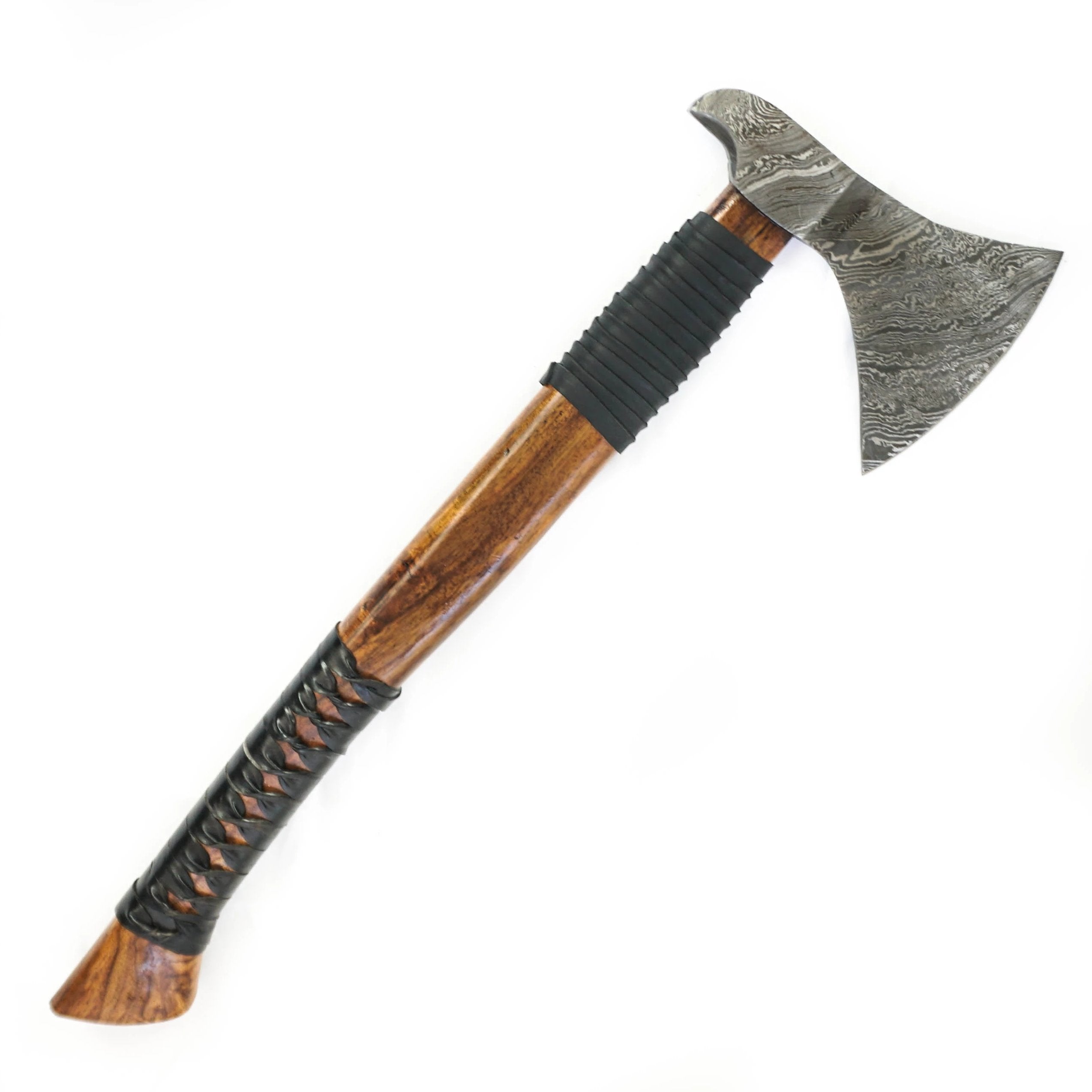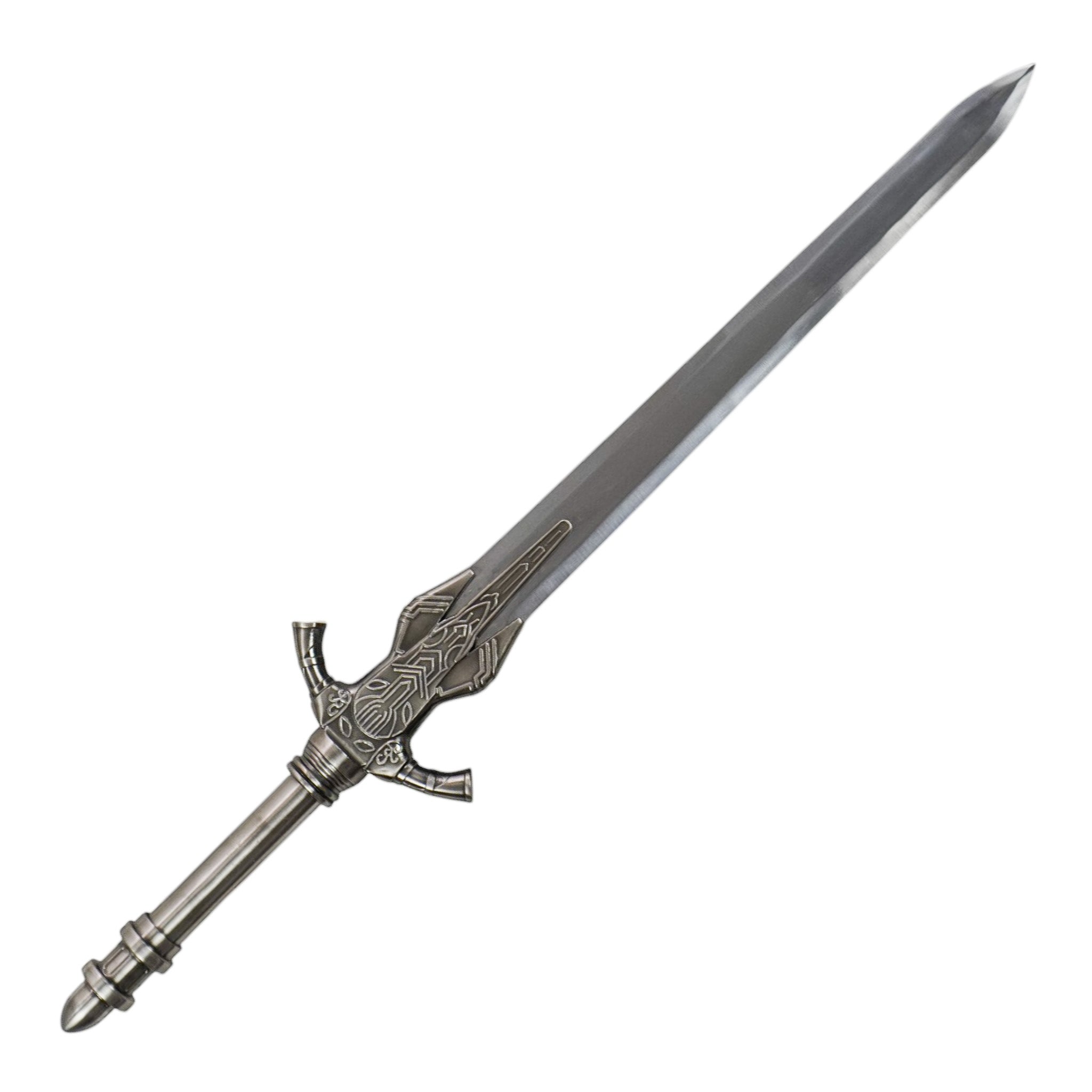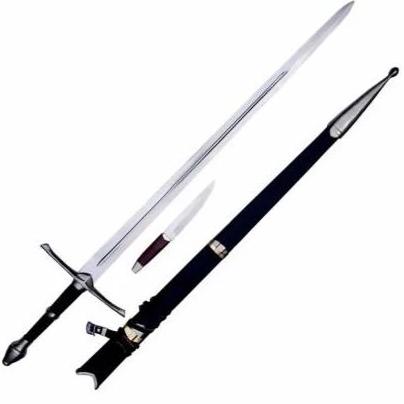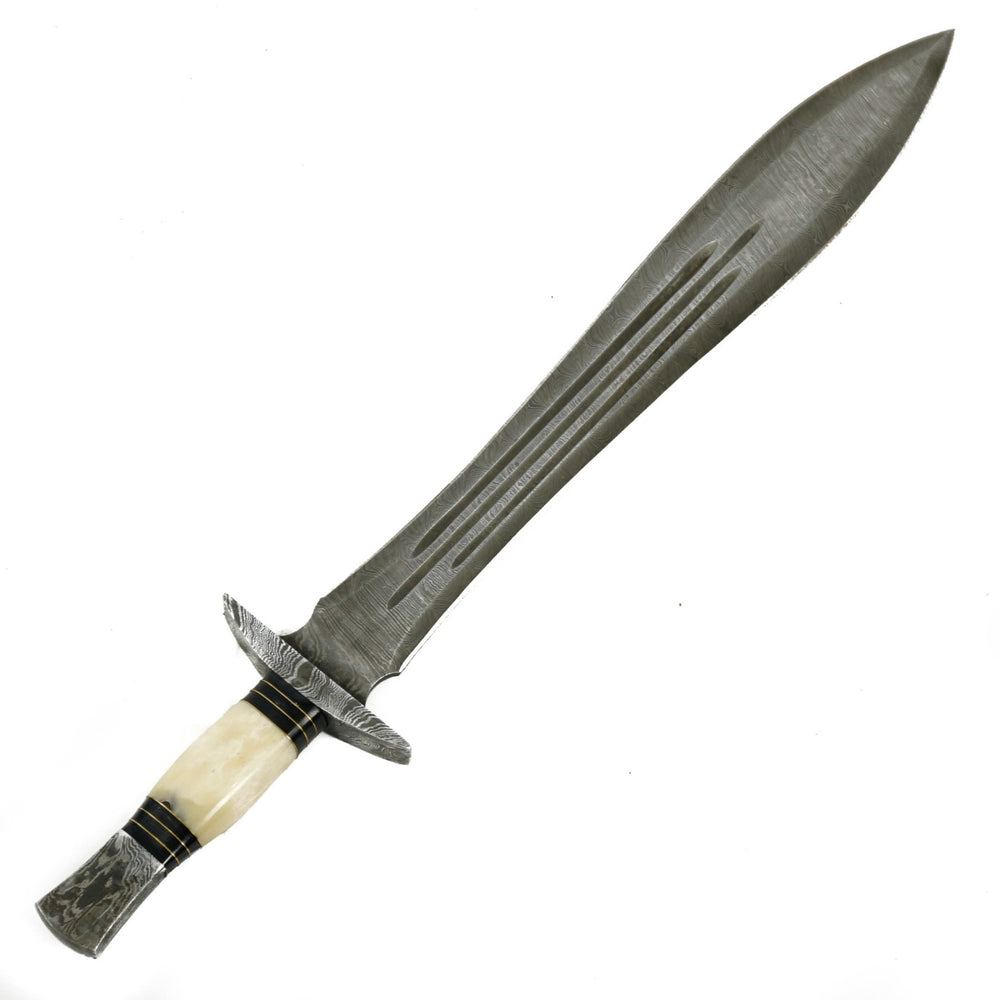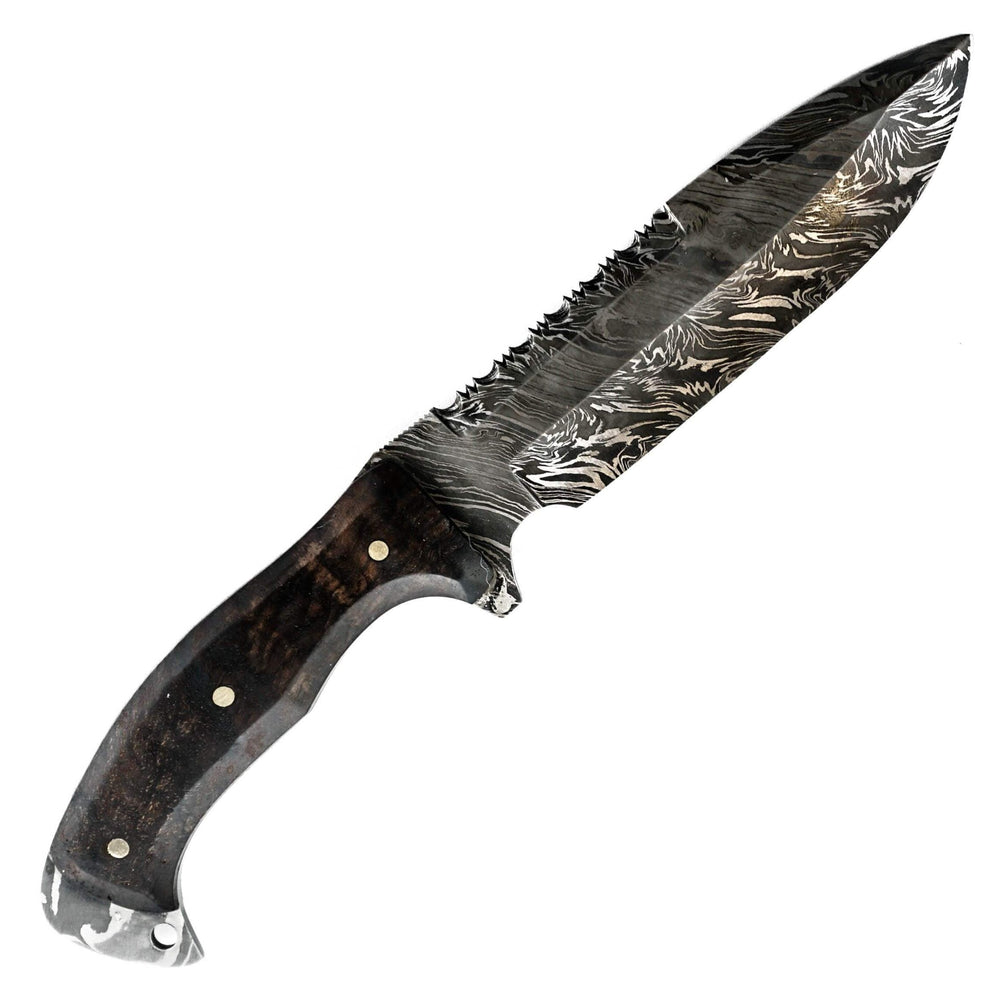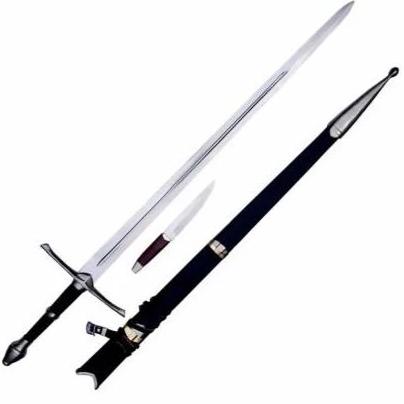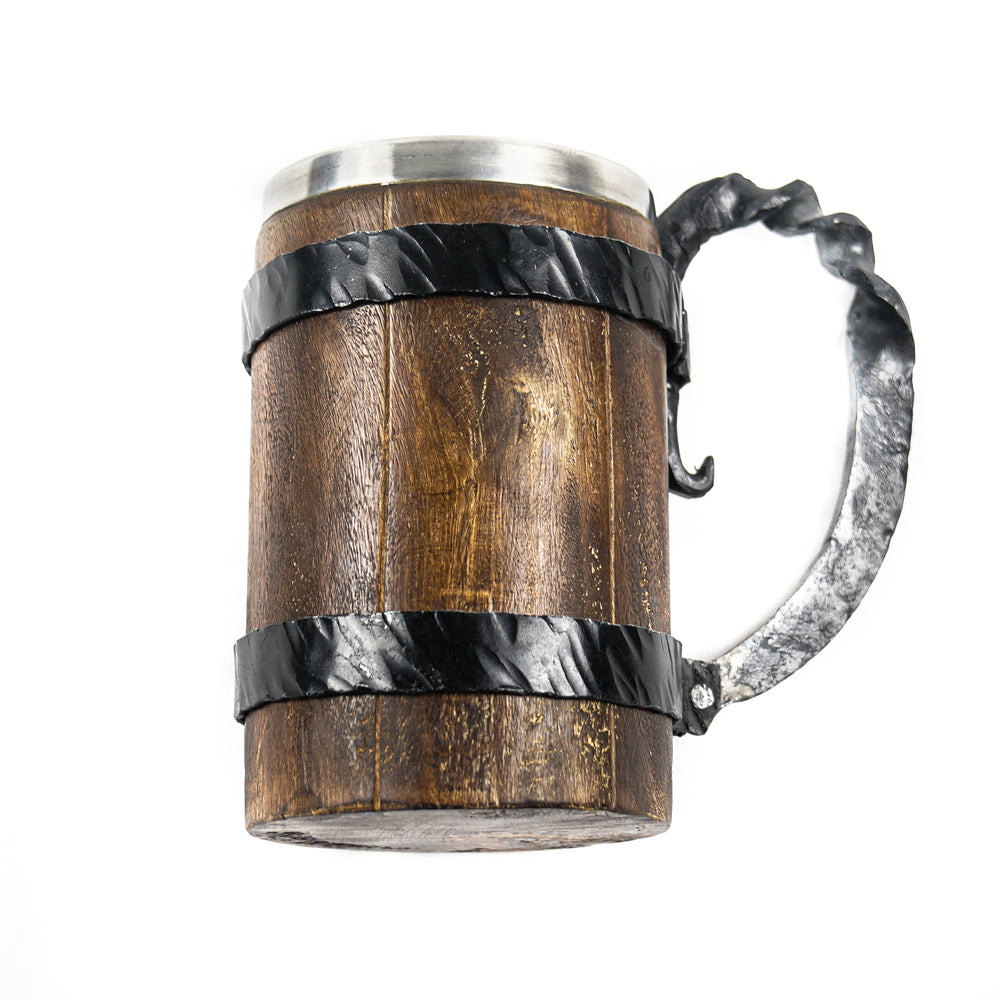A Versatile 'Bastard' Sword: A Comprehensive Guide to the Hand-and-a-Half Sword
For anyone interested in medieval weaponry, the term ‘bastard sword’ or 'hand-and-a-half sword’ is not new. After all, so many in the medieval period boasted the use of this sword in wars, battles, and even ceremonies.
It's a versatile and effective weapon. Thus it is no surprise the half-and-a-half sword has captured the attention of sword enthusiasts.
Keeping that in mind, this article will build on that enthusiasm to talk about the hand-and-a-half sword. Moreover, it will cover the history, design, techniques, combat usage, and comparison with other swords.
Of course, we’ll also talk about famous examples and how you’re supposed to take care of your hand-and-a-half sword replica.

Speaking of replicas, if you’re too impatient and really want to check out real-life reproductions first, visit Battling Blades! As a premier medieval weapons reproduction specialist, it won’t disappoint.
What Is The Hand-And-A-Half Sword?
This incredible sword is a weapon that boasts a blade that is longer than a one-handed sword but shorter than a longsword. This makes it a little different from previous swords of the medieval era.
Moreover, the very name "hand-and-a-half" also holds a specific meaning. It comes from the user of the weapon being able to wield it with both one hand and two. It all depends on what is required from the battle, but it makes it majorly useful.
It’s also called various other names, like the Hand-a-half sword, though admittedly, “Bastard sword” is more popular. It is also sometimes mistaken for a longsword, though there are differences there that this article will explore.
Regardless of the name, the sword’s versatility and adaptability made the hand-and-a-half sword pretty popular! Knights and Warriors especially remained in awe of it through the medieval period.

History of the Hand-and-a-Half Sword:
You can trace the origins of the hand-and-a-half sword back to the late medieval period. It began to gain traction around the 14th century, according to historians.
However, the exact dates in answer to "When was the sword invented?" might be more difficult to consider.
After all, it’s difficult to track when usage ensured the continued production of a weapon, right?
Still, it was also around that era that armor started becoming more intricate and sophisticated.
Swordsmiths were experimenting more in those times to figure out ways to penetrate the new and improved armor.
The creation of the hand-and-a-half sword was an obvious answer to the needed versatility. It was, in the end, a weapon that could be used in multiple kinds of combat situations. After all, the size and design allowed it to be used interchangeably with one hand or two.
In any case, the sword became even more popular during the 15th century’s Hundred Years' War. While France and England battled for dominion, half-swording and half-swording techniques using this blade became famous.
Both sides used it, and it became a true favorite among knights and foot soldiers. In fact, the way it pierced through armor to deliver deadly blows made it an essential tool on the battlefield!
The hand-and-a-half sword also continued to perpetuate through the 16th century. However, it underwent a few design alterations, especially when the Renaissance period rolled around.
For example, the blade was made to be narrower and longer, which did make it more suitable for thrusting attacks. Opposingly to this practical change, however, the hilt was made more decorated and bejeweled, mostly for status.
Still, the enduring popularity of the sword has not waned even today. Though it fell out of use in the battlefield, it is popular among both sword enthusiasts and historical reenactors.
If you’re interested in being one of them, we offer various hand-and-a-half swords at Battling Blades. These swords are faithful reproductions of historical blades you might have considered owning.
And if you’re interested in swords other than Bastard swords, we’ve got a whole collection of options!
Design and Characteristics:
As previously explained, the hand-a-half sword is referred to as a Bastard sword. It’s a versatile weapon that users can wield with just a single hand or both if they want. That has everything to do with its design, and we’re here to talk about that!
Here are some defining characteristics of the Bastard sword that you should know about:
Blade:
With a typical length of between 33 and 37 inches, the blade of the hand-and-a-half sword is no easy foe.
It has a double edge that makes it doubly dangerous, and, more importantly, it’s strong and flexible. It easily absorbs heavy blows by an opponent's sword without breaking!
Hilt:
The hilt of this blade is longer than that of a one-handed sword and shorter than a two-handed sword. This makes it easier for the wielder to hold it with one or two hands and justifies the name “Hand-and-a-half”! Cool, right?
In any case, the hilt tends to be wrapped in leather to improve the grip. Though it can be substituted with other materials.
Pommel:
The sword's pommel refers to the knob at the hilt's end. This part of the sword functions as a balance and counterbalance to the weapon's weight.
Not to mention how you can always use it as a blunt tool in close combat! You don’t just have to cut the enemy - you can always hit them on the head instead!
Crossguard:
The crossguard is the horizontal bar extending from the hilt to protect the wielder's hand. It keeps the user from losing their sword since it minimizes the chance of the hand being injured. This makes it a pretty useful part of the sword!
Moreover, it can have multiple sub-designs, like being straight, curved, or even decorated.
Hand-and-a-Half Sword vs. Longsword:
While people confuse the hand-and-a-half sword with the longsword, the two differ in certain aspects. In simplest terms, the Longsword tends to have a longer blade and, most importantly, is generally two-handed.
The hand-and-a-half sword, however, boasts a shorter hilt and blade. And, as the name explains (as this article has mentioned), it can also be wielded by just one hand.
Don’t worry about such a simplistic comparison! This is only to whet your appetite… we have a larger section on the comparison coming up. We just had to include this here to confirm that design and characteristics are how these two weapons differ.
Battling Blades has a fairly good selection if you’re interested in finding a reproduction. For example, of their hand-and-a-half swords, the White Bastard Sword has a great design. If you’re a collector or reenactor, that sword will surely make you stand out!
Techniques and Combat Usage
The hand-and-a-half sword was a versatile weapon that has long been used for a multiplicity of combat techniques. In skilled hands, it could be deadly in both close- and long-range battle scenarios.
With that in mind, let’s look at some recorded sword techniques that the history of the hand-and-a-half sword boasts.
Half-Swording
Half-swording is where the wielder grips the hilt of the blade with one hand. By placing their hand in the middle, the wielder is able to use it as a short spear. Not only does this technique provide great control over the sword’s point, it also boosts the accuracy of thrusting attacks.
Two-Handed Grip
The two-handed grip allows the wielder to grip the sword with both hands, obviously. It allows greater power and control due to the maximum power of the wielder being behind the hilt. This technique is often used for powerful slashes and overhead strikes.
One-and-a-Half-Handed Grip
It may sound confusing, but the one-and-a-half-handed grip is easy to understand. For this, the wielder grasps the sword with one hand and a half! In simpler words, that means that the second hand is used to grip the pommel or base of the blade.
This sword-hand technique gives the wielder greater control over the sword's swing. At the same time, the speed and agility of the one-handed grip are retained!
Versatility in Combat
In terms of generic combat situations, it’s true that versatility would be essential. The hand-and-a-half sword's design and weight distribution provide that versatility.
It has, after all, been effective against both armored and unarmored opponents throughout history. In addition, it can also be used for different kinds of attacks, such as cutting and thrusting.
Noting the above combat situations and sword techniques, we can conclude that the hand-and-a-half sword was a highly effective weapon. This sword was a must in the era for medieval knights and soldiers.
That’s also why Battling Blade offers an entire collection of Bastard swords as replicas! Just like the hand-and-a-half sword remained relevant on the battlefield for centuries, its reproductions will remain relevant for history.
We recommend checking out this Bastard Sword. Made from pure High-Carbon Damascus Steel, this 37-inch sword perfectly represents hand-a-half swords!
Hand-and-a-Half Sword vs. Longsword
When you think of medieval swords, the longsword and the hand-and-a-half sword are probably what come to your mind. This has also often forced them to be coxed into the same level of description.
Fortunately, while there are similarities, there are a few pretty glaring differences. We’re here to explore those! This section will talk about these differences and their impact on combat usage.
Length and Weight
In generic terms, the two swords differ greatly in terms of typical length and weight.
Longswords generally have a blade length of around 36 to 40 inches and weigh between 2.5 to 4 pounds. Oppositely, hand-and-a-half swords are shorter and lighter. They have a blade length of around 33 to 37 inches and a weight of 2.5 to 3.5 pounds.
They may be similar in the lower ends, but the greater you make the sword, the greater the difference. This is relevant for both size and weight.
Grip
Firstly, Longswords have a longer grip because the sword is designed for two-handed use.
Hand-and-a-half swords have a shorter grip that can be used with either one or two hands.
This makes the hand-and-a-half sword more versatile in combat situations, allowing the user to switch between one- and two-handed grips. (Though it does make the sword a little more difficult to master!)
Blade Geometry
The blade geometry of the two swords is also different. Longswords typically have a wider blade, designed for cutting and slashing. Whereas hand-and-a-half swords have a narrower blade with a more critical point, making them better suited for thrusting and piercing.
Combat Usage
As their designs and characteristics differ, so do their combat applications. You can see from the previous discussion of one vs. two-handed the beginnings of that debate.
Still, let’s consider it in depth. Longswords, for one, are better suited for fighting on the battlefield. They cut through armor more easily and deal heavy damage on top of that.
Hand-and-a-half swords, though, are more suited for duels and one-on-one battles. Switching between two grips and leveraging versatility can provide a better advantage with only one opponent.
Interesting comparison, right? It just makes you want to have these swords all for yourself. Please
If that’s you, look no further than Battling Blades! We’ve recommended quite a few Bastard Swords, so let’s talk about Longswords for now. For example, the King’s Sword Longsword has an elegant design and superb craftsmanship. It’s no wonder this longsword is so in demand!
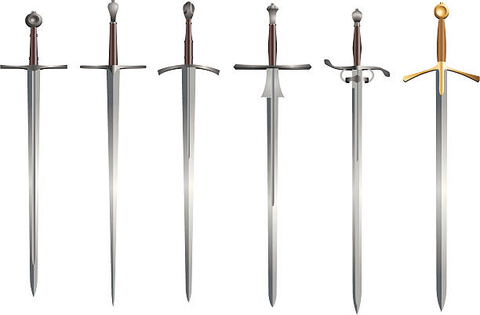
Even beyond longswords, our collection of swords is carefully crafted by skilled artisans using the highest quality materials and techniques. Check out more of these swords at our website, and don’t hesitate and check out these reproductions today!
Famous Hand-and-a-Half Sword Examples:
Countless hand-and-a-half swords have played significant roles in warfare, legends, and myths throughout history. And those are what we’re here to discuss!
1. The Sword of Saint Maurice
This hand-and-a-half sword belonged to Saint Maurice, who was a Christian martyr and the patron saint of soldiers. According to legend, this sword possessed ‘great power’. Also, it has long since been represented in artwork with a hand-and-a-half hilt.
2. The Sword of Goujian
This sword is believed to have been made around 500 BCE during the Spring and Autumn period. It was discovered in 1965 in China. Beyond the history, note that the sword has a hand-and-a-half hilt, making it an example of a bastard sword.
3. The Sword of Albrecht Dürer
This blade belonged to the famous German artist Albrecht Dürer and is currently on display at the Germanisches National Museum in Nuremberg, Germany. The sword has a hand-and-a-half hilt and is decorated with intricate ornate engravings.
4. The Wallace Sword
This Scottish sword dates back to the late 15th century and is named after its most notable owner, Sir William Wallace. Sir Wallace fought for Scottish independence using this sword with a prominent hand-and-a-half hilt and a long blade.
5. The Oakeshott Type XVa Sword
This sword is anointed after the British historian Ewart Oakeshott. He classified medieval swords based on their design characteristics. The Oakeshott Type XVa sword has a hand-and-a-half hilt, granting it an easy position on this list.

All these swords represent a unique piece of history and offer a glimpse into the artistry and craftsmanship of medieval sword-making. Still, while many of these swords are now relics of the past, they continue to inspire countless sword enthusiasts today.
You can find your own reproductions at Battling Blades if you want!
Care and Maintenance
A well-maintained hand-and-a-half sword can last a long time, even centuries. You must be vigilant in properly caring for your sword to ensure its longevity and effectiveness.
Here are some tips when keeping your hand-and-a-half sword in top condition:
Clean your sword after every use:
You also need to regularly clean your sword after every use to prevent rust and corrosion. First, wipe down the blade and handle. For this, you can use a soft, moist cloth as it’ll make the cleaning process easier.
However, once you’re done with this step, always remember to use a dry cloth so there is no moisture left after you’re done.
Oil the blade:
Using oil will help prevent rust and corrosion, so make it a habit to oil the blade with a thin layer of lubricant regularly. You can use mineral oil or specialized sword oil for this purpose.
Store the sword properly:
Ensure it's dry and cool to prevent rust and corrosion. Avoid storing it in a sheath for long periods, as this can trap moisture and lead to rust.
Sharpen the blade:
Use a stone or file to keep the blade sharp, but be careful not to remove too much material.
Check for any signs of damage:
Inspect your sword regularly so that you're aware of if there show up any cracks or chips in the blade. If you notice any damage, take your sword to a professional for repairs.
On the other hand, if your sword can no longer stick faithfully by your side, don’t worry too much! Battling Blades has a whole collection of Bastard Swords you can choose from.
The Bottom Line
The hand-and-a-half sword is a fascinating and versatile weapon with a rich history. Its design and characteristics make it well-suited for both one-handed and two-handed use. This also allows for a wide range of techniques and combat styles.
So while it may be similar to the longsword, the hand-and-a-half sword is a weapon of its own regard.
Moreover, whether you use it in battle or as part of a reenactment, you must take care of the blade. Proper care and maintenance of a hand-and-a-half sword is essential for preserving its longevity and performance.
After all, a well-made sword can last for generations with the right techniques, such as regular cleaning and oiling. (And you can find such well-made swords at Battling Blades!)
In short, the hand-and-a-half sword is an unchanging symbol of medieval combat and craftsmanship. Having proved itself by capturing the imagination of countless people today, know that its timeless legacy will never fade.

